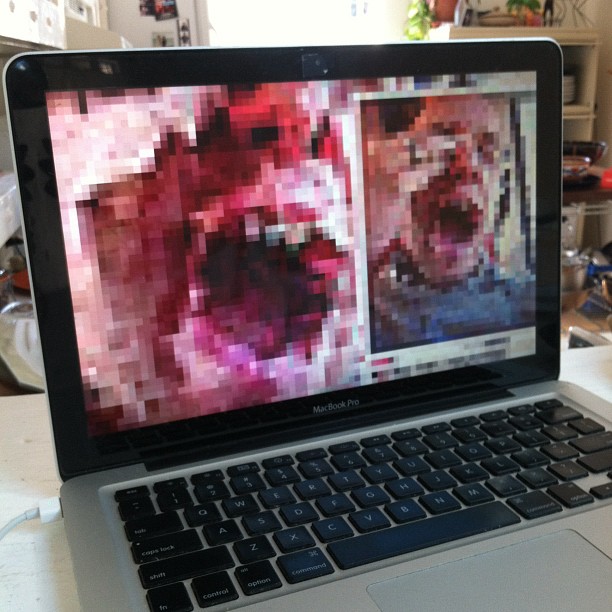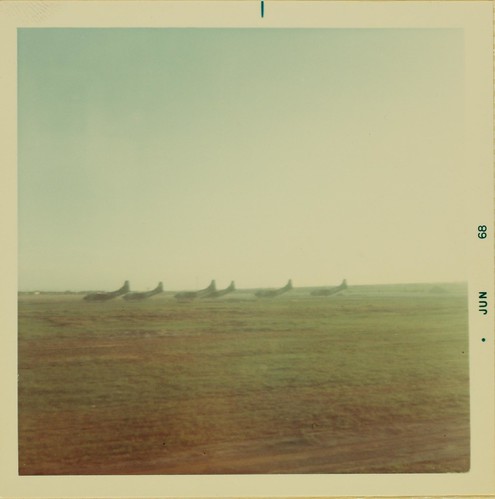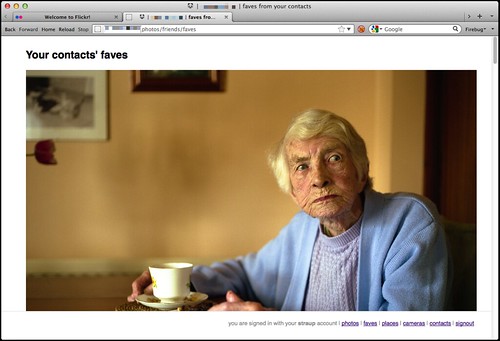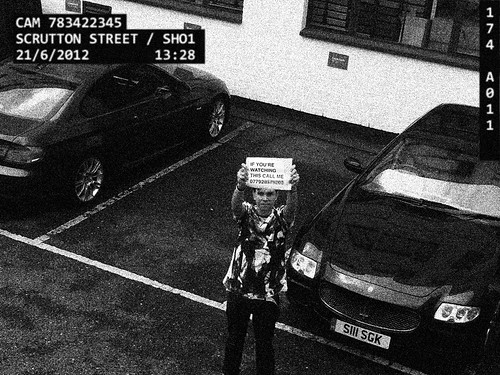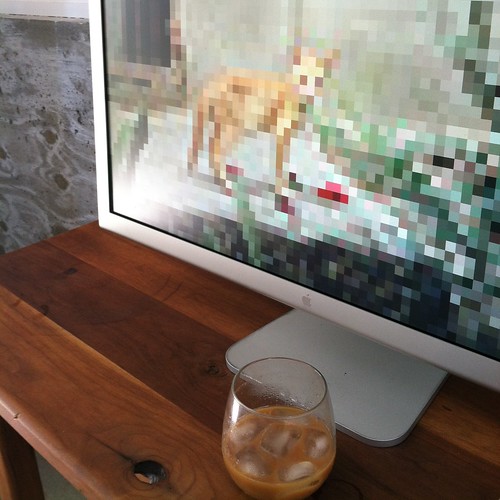for some definition / of sweating the details
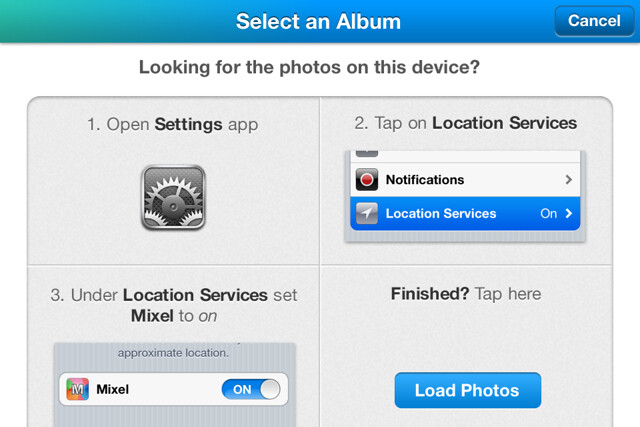
This dialog makes total sense, right? The device is the map or something like that.
I can only imagine that Apple's security/paranoid people made the case that the geo information embedded a user's photos should be treated as being like "Location services" information. Because it is.
If I were a bad person I wouldn't think twice about writing an iPhone app that silently hoovered up all the timestamps and coordinates in a user's photos. For some definition of useful data-mining.
I'm not sure how to feel about all of this. Actually, I know exactly how I feel: That I would rather service providers (Apple, Flickr, etc.) err on the side of caution when it comes to photos and geo. The consequences of getting it wrong simply outweigh any nonsense about living in an ephemeral public where we have transcended shame, nevermind simple privacy, in favour of a more zippy user interface.
I also recognize that how you frame the question can often poison the well. The screenshot above is a pretty good example of that. It is not at all clear why Mixel needs to use the geo EXIF information (I presume) in my photos. Like I said, it's probably more a function of the fact that they are being given access to that information and there's no way for anyone to gauge their ultimate motive beyond imagining the worst case scenario.
I suppose that Apple could write custom operating system layer functions for reading images directly from the filesystem that filtered out information, stored in those photos, based on a user's preferences. That would certainly be elegant but if you told me it was a solution which oscillated between impractical and impossible I wouldn't be surprised.
Instead we're left trying to find ways of depicting the smushing together of years and years of social convention and expectations with the relentless march of what is technically possible inside the confines of someone else's user interface guidelines.
Good times.
Meanwhile, at least of this writing if you search for geo exif
in Google the top result is the account settings page, on Flickr, for automatically geotagging your photos using emebedded geo EXIF information. That's kind of nice and if you're curious the default is to not import that information. For all the reasons outlined above.

This blog post is full of links.
#detailsthe future is here / it just has an internal logic error
The image above and the story below are unrelated. Unless you count the magic happy cloud-app world — and Cory Doctorow's war on general purpose computing — that we're all being encouraged to embrace. Maybe these are just growing pains and instances of exceptionally bad design but I'm posting both these stories here as a snapshot of a moment in time and a public service announcement.
It's all relative, right? Three quarters of a billion people didn't even have electricity in India yesterday because the grid itself failed...
ASC: also, file vault it turns out that in 10.7 + file vault not only encrypts your disk but rewrites the firmware so if you forget your password (like me on my ... laptop last week) you're basically fucked for some kafka-esque definition of fucked Me (to the apple guy) : that's weird, I would have thought you'd have a tool for re-rewriting the firmware Him : well, that's the thing about back doors – if we have one then someone else could get their hands on it Him : but we think we have the solution MM: urk. ASC: Him: we're going to install 10.8 and that should fix the problem since it rewrites the firmware Me : ... MM: I am confused AA: no shit the whole thing is a mess first: the part where file vault bricks your laptop instead of simply encrypting your data second: the part where they don't have a tool for fixing the firmware unless you count [the next version of the operating system] MM: I totally don't get the firmware thing I mean... is the laptop fucked as in won't-run? or fucked as in data-gone? ASC: it's so that someone "can't steal your laptop and just reinstall the OS" apparently fucked as in: you can't wipe the disk and start over again if you try to reinstall the OS on a disk with file vault you get asked for a) your password b) that insane long file vault master key that no one ever writes down I thought I could work around that problem by simply reformatting the entire disk and reinstalling from apple's magic network servers since and this part is awesome there is no way to get the bloody operating system on "removable media" unless you count the firewire drives with the last 18 versions of OS X that all the worker bees at the apple store walk around with MM: right, that's what I would expect data safe but, laptop still usable? ASC: but that scenario basically blew OS X's mind and it just shat the bed so no – the machine just bricked itself MM: ... ASC: I love file vault ASC: I did not expect file vault to fuck up the firmware though - that's just stupid and wrong
This blog post is full of links.
#logicPixel Shag
A shag is a rug or carpet that has a deep pile, giving it a shaggy appearance. Shag carpeting is sometimes evoked as an example of the esthetic from the culture of the 1970s in the United States and United Kingdom.
In recent years, shag carpeting has seen a resurgence of popularity.
A couple months ago, Dan Hill wrote a really interesting blog
post titled Essays:
Interfaces for the unlimited dream of flying
. It's a
medium-length Dan Hill exploration of the design of airplane
cockpits and the not so gradual transition from a cone-shape box
covered in knobs and dials to a pair of tastefully mounted iPads
with buttons for the few remaining high-level actions left for
pilots to perform. I don't think anyone knows whether this
is a good idea, functionally or otherwise, just that it's happening.
You know what the craziest thing about this photo is? It was not taken with Instragram. No, really. Crazy, right?
Shortly afterward, The Telegraph published Nick Ross and Neil Tweedie's article about the Air France 447 crash over the mid-Atlantic in 2009: Air France Flight 447: 'Damn it, we’re going to crash’
. The findings that the Telegraph reported on were then recapped with a focus on the capital-D design issues in Mark Wilson's FastCoDesign article: How Lousy Cockpit Design Crashed An Airbus, Killing 228 People
.
All three pieces are worth reading, if you haven't already. In the case of the Air France crash a lot of attention is focused on the lack of any kind of visual or force feedback in the design of the Airbus steering column. Ross and Tweedie do a better job than I would describing the problem:
Like all other aircraft in the modern Airbus range the A330 is controlled by side sticks beside pilots’ seats, which resemble those on computer game consoles. These side sticks are not connected to the aircraft control surfaces by levers and pulleys, as in older aircraft. Instead commands are fed to computers, which in turn send signals to the engines and hydraulics. This so-called fly-by-wire technology has huge advantages. Doing away with mechanical connections saves weight, and therefore fuel. There are fewer moving components to go wrong, the slender electronic wiring and computers all have multiple back‑ups, and the onboard processors take much of the workload off pilots. Better still, they are programmed to compensate for human error.
The side sticks are also wonderfully clever. Once a command is given, say a 10-degree left turn, the pilot can let the stick go and concentrate on other issues while the 10-degree turn is perfectly maintained. ... But the fact that the second pilot’s stick stays in neutral whatever the input to the other is not a good thing. As King concedes:
It’s not immediately apparent to one pilot what the other may be doing with the control stick, unless he makes a big effort to look across to the other side of the flight deck, which is not easy. In any case, the side stick is held back for only a few seconds, so you have to see the action being taken.
Which is an interesting and useful counterpoint to Dan's post. The running joke is that pilots don't really do much
flying anymore. Rather, they mostly just deal with
take-offs and landings and otherwise point the giant sensor
tubes that airplanes have become in the general direction of the
final destination and let the computers take care of any course
corrections that occur. But everything breaks, right? As it
happens I am SKYBLOGGING this post from 35, 000 feet and reading
about all the fallout from Amazon's Virginia data center being
attacked by the SKY (what you call lighting
) and taking down everyone's
favourite cloud
services that were hosted there.
And that's the place where people start needing to be able to fix (or fly) things by hand. That is the place where people need to see as much information as possible and to use their supposedly tiny meat brains to to process it in to a decision about what to do next, even if it seems completely illogical. It is true that we probably would not have gotten to the moon without computers but it's also worth remembering that for the landing itself the astronauts turned the computers off and guided the moon lander to the surface by touch and feel.
So from a safety perspective that essentially means the
future of cockpit design will dictate that they be covered in
360 degree screens that will spend 99.99% of their working lives rendering
nothing more than the airplane equivalent of shag
carpeting. Only in the proverbial 0.01% of crisis
situations would they come alive
and present the thousands of sensors and charts and graphs and knobs and
buttons that are the reality of airplanes, old and new.
I'm not really sure what the bridge between that story and this next one is but over the last few months I've been re-implimenting some older Flickr API apps I wrote using Google's AppEngine stack on top of the Flickr PuSH APIs: Contacts Who've Faved (cwf) and Flickr For Busy People (ffbp). AppEngine remains a lovely thing to have in the toolbox but it has evolved to become so specific to Google's infrastructure that, good or bad, it's a bit of a locked box. So, I've been adding the functionality to parallel-flickr and using the work as an opportunity to play with the interface design of the applications.
There isn't much to say about ffbp (in parallel-flickr) yet. It is arguably worse than the original so we'll just talk about cwf, instead. The earliest redesign of cwf simply opted for displaying a big honking version of each photo, along the lines of Pua, the first app I built using the Flickr PuSH stuff. Unlike Pua, though, there's an expectation of more control and feedback. Things like seeing who took a photo and who faved it or basic navigation controls. Also, big photos are big. So the big photos were replaced with the standard 500 pixel version and I used Scott Robbin's excellent Backstretch library to blow a thumbnail version of the photo in to big chunky pixels.
I honestly don't remember if the big chunky pixels was me riffing off the work that Dan Catt was doing at the same time for the Guardian Ambient Headline Radio project or if it was other way around. Either way this screenshot was pretty much an OHFUCKYEAH moment for me, when I saw it:
Earlier this year, I muled a t-shirt that James Bridle had ordered to Austin. He wanted to
wear it for the innocent little
panel with an eye for pixels we were both a part of at SXSW. James
loves his t-shirt but it is a truely hideous design and I quickly dubbed it the
ugly shirt
after the fashion accessory with the same name in William
Gibson's novel Zero History. In the novel the
ugly shirt is used to trigger, by means of its signature
patterns, a switch in London's CCTV computer vision algorithms that prevents the wearer from being recorded.
Which is why it was so lovely to watch James, a few months after SXSW, posting this photo to Flickr:
And see it turn in to this when someone I follow, on Flickr, faved it:
That's not the ugly shirt if you're wondering. This is.
The most recent work on cwf has involved making it more
Pua-like so that it can be run as a friendly second screen
slowly looping through the pool of new and available photos that
your contacts have faved. But instead of displaying the photos
proper it's meant to display the out-of-scale pixelated
thumbnails in all their blocky goodness. It really only works
well in Firefox because it is the only browser that implements and
honours the crisp-edges
CSS flag(s) for images.
Everyone else is too bent, it seems, on the illusion of a perfect mirror world to notice the possibilities at hand.
The innocent little panel
I mentioned earlier was
the now infamous New
Aesthetic panel, a conversation about and around ideas that James and others have been
chasing since last year. Since then the whole thing has gotten all
sorts of attention and, in its own
way, been Internet-meme-cat-lol-ified. It has become something of a
Rorschach circus show, causing people to put their cards on the
table in all sorts of weird and unexpected ways. One of the questions that has been raised, or
simply pointed out, is whether or not the project betrays an unhealthy nostalgia for the past and
a fetishization of early 8-bit computer graphics from the 80s.
That's always seemed like a fair critcism to me but increasingly I've been coming to the conclusion that it's just not the case. At least not for things like cwf or Dan's more recent projects like Flambient (which I've also been slowly adding to filtr). I think there's something different going on. Back when people only had 8-bit colours and low resolutions to work they only had... well, 8-bits worth of colour. But now we have more colours than ours can see (so we're told). So that means that the possibilities available for dressing up the grid, an otherwise pretty tired and flavourless medium, can be both more subtle and more complex.
This is really about the magic of colour and as much as I am bored silly of his work it's hard sometimes not to want to stand on the corner shouting FUCKYEAHCEZANNE.
At Foo Camp, this year Greg Borenstein and Matt Webb led a
session titled Designing For and Against the Manufactured
Normalcy Field
. Greg's
done a good write-up on his website so I won't repeat it here
except to say that you should also go read the catalyst for
the session: Venkatesh Rao's Welcome
to the Future Naseous
.
I have some doubts about the idea of a normalcy field or why it's necessarily a bad thing. I may have mentioned that I am SKYBLOGGING this post, sitting in a chair 35, 000 feet about the ground and traveling at 500 miles an hour. Drinking whiskey. I'm just not sure I buy the argument that I should to be experiecing the essence of this event if only because I wouldn't be able to get anything else done. The whole point of these offenses against spacetime is to make possible something new and sometimes the cost is abstracting away the fleshy reality of our earthly bodies. Given how long it's taken me to finally sit down and write this blog post I think I can live with that.
One of the things that Matt asked people at the Foo session was list things that feel weird. The short-hand answer for the things people came up with is the self-driving car. I've been wondering whether the reasons that people get so creeped out by the self-driving car (and things like it) is that they are born in to this world devoid of irrationality. Don't get me wrong. I'm not particularly keen for this airplane to, of its own volition but with no discernable explanation, simply decide to start doing anything other than what it's doing right now.
But I also think that we use, we rely, on the notion that people are very much irrational. It keeps things interesting. It also means that there are strategies (both benign and creepy) for navigating a world of other people by being able to account for and manipulate that irrationality. Things like cars with mass and velocity and the ability to create serious and permanent carnage are, out of necessity, not allowed a lot of latitude. This is another compromise I can live with but that absence of room to maneouver when evaluating the world around us is, I think, deeply troubling to people even if it's not something that is readily articulated.
One day during Foo I walked in to a room and saw that someone
had written the words: If Siri wins
what will
it do? I don't have a phone with Siri but I've seen enough
people use it, and heard enough stories, that I think the reason people like
it more than the self-driving car is simply that
you can fuck with it.
You can ask Siri simple, selfish and formal questions and it will give you
simple, formal and selfish answers. That's useful sometimes. But
people have also figured out that you can feed Siri a milkshake of
a question then they just sit back and wait to see what comes
out. There's enough wiggle room in the way Siri is designed to
operate people understand that there are all these corners where
you can make crazy shit happen. Where you can find the
unexpected in what is otherwise nothing more than zeros and
ones. It doesn't really matter whether or not there are
people
in there
because it's a valuable lens to
see the world through.
A lens where you don't know what will happen.
An update, two years later: Just saying...
This blog post is full of links.
#pixelshag